View in other NatureServe Network Field Guides
NatureServe
Montana
Utah
Wyoming
Idaho
Wisconsin
British Columbia
South Carolina
Yukon
California
New York
Half-moon Hairstreak - Satyrium semiluna
Other Names:
Satyrium fuliginosa semiluna
Native Species
Global Rank:
G4
State Rank:
S4
Agency Status
USFWS:
USFS:
BLM:
External Links
General Description
[From Ferris and Brown 1981; Scott 1986; Opler and Wright 1999; Glassberg 2001; Pyle 2002] Forewing 1.3-1.4 cm. Tailless. Uppersurface gray to brown, unmarked, lacks strong dark bar at end of forewing cell, fringe of forewing light gray to light tan. Undersurface of hindwing sooty gray, an obscure irregular postmedian series of small black spots circled with white, an even more obscure submarginal series of spots, a small obscure whitish bar in the discal cell.
Phenology
One flight; mainly July (Scott 1986). May to mid-September but mainly July and August (Glassberg 2001). Late May to late August and early September in Oregon and Washington (Pyle 2002; Warren 2005), late May to early July in British Columbia (Guppy and Shepard 2001).
Diagnostic Characteristics
Best determined by the uppersurface lacking the strong dark bar at end of forewing cell, the under hindwing with an obscure irregular postmedian series of small black spots circled with white, an even more obscure submarginal series of spots, a small obscure whitish bar in the discal cell.
Species Range
Montana Range
Range Descriptions
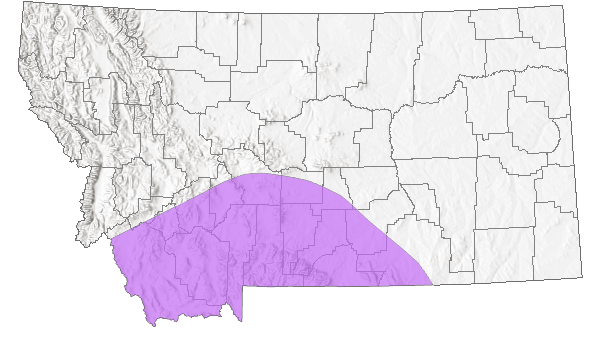
 Native
Native
Range Comments
Extreme southern British Columbia south to northeastern California, northern Nevada, and east across southern Idaho, southwestern Montana, western Wyoming to northern Utah and Colorado (Scott 1986; Opler and Wright 1999; Glassberg 2001; Brock and Kaufman 2003); usually between 2286 m and 2743 m elevation in Rocky Mountain states (Ferris and Brown 1981), 549 m to 2591 m elevation in Oregon (Warner 2005). In Montana, reported from at least nine counties in the southwestern part of the state (Kohler 1980; Stanford and Opler 1993). Uncommon to common (Glassberg 2001).
Observations in Montana Natural Heritage Program Database
Number of Observations: 2
(Click on the following maps and charts to see full sized version)
Map Help and Descriptions
Relative Density
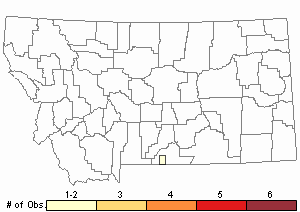
Recency

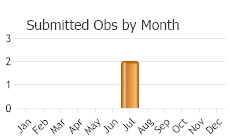
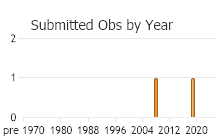
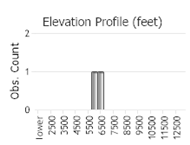 (Observations spanning multiple months or years are excluded from time charts)
(Observations spanning multiple months or years are excluded from time charts)
Migration
Non-migratory.
Habitat
Sagebrush steppe on hills and slopes, montane meadows, roadsides, pine forest openings (Scott 1986; Opler and Wright; Glassberg 2001; Pyle 2002). Reported from meadows in pine forest, dry mountainsides, rolling grassland, roadsides in the Greater Yellowstone Ecosystem (Debinski and Pritchard 2002).
Food Habits
Larval food plants include at least eight species of Lupinus (Scott 1986, 1992; James and Nunnallee 2011). Adults feed on flower nectar, including Arnica, Eriogonum, Purshia, Senecio, and Tetradymia (Pyle 2002; Scott 2014).
Reproductive Characteristics
Females lay eggs singly or in small clusters low on host plant stem or in litter near base (Scott 1986, 1992; James and Nunnallee 2011). Eggs overwinter, hatch within 2 days after exiting diapause (depending on temperature). Larval L1 instar reaches L2 and L3 instar in 4-5 days post-hatch, L4 in 9 days post-hatch, pupate 19-20 days post-hatch. Adults eclose (emerge from pupa) in 13 days (33 days post-hatch). Larvae build no nests, are nocturnal, feed on leaves, flowers, in stems, may be tended by ants (Scott 1979, 1986, 1992; James and Nunnallee 2011). Males perch on shrubs (including larval host plant) often on or near ridges, patrol erratically every few minutes around host plant canopy, in search of females (Scott 1975b, 1986).
Stewardship Responsibility
References
- Literature Cited AboveLegend:
 View Online Publication
View Online Publication Brock, J.P. and K. Kaufman. 2003. Kaufman Field Guide to Butterflies of North America. Houghton Mifflin Company, New York, NY 284 pp.
Brock, J.P. and K. Kaufman. 2003. Kaufman Field Guide to Butterflies of North America. Houghton Mifflin Company, New York, NY 284 pp. Debinski, D.M. and J.A. Pritchard. 2002. A field guide to the butterflies of the Greater Yellowstone Ecosystem. Lanham, MD: Roberts Rinehart Publishers. 107 p.
Debinski, D.M. and J.A. Pritchard. 2002. A field guide to the butterflies of the Greater Yellowstone Ecosystem. Lanham, MD: Roberts Rinehart Publishers. 107 p. Ferris, C.D. and F.M. Brown (eds). 1981. Butterflies of the Rocky Mountains. Univ. of Oklahoma Press. Norman. 442 pp.
Ferris, C.D. and F.M. Brown (eds). 1981. Butterflies of the Rocky Mountains. Univ. of Oklahoma Press. Norman. 442 pp. Glassberg, J. 2001. Butterflies through Binoculars: A Field Guide to the Butterflies of Western North America. Oxford University Press.
Glassberg, J. 2001. Butterflies through Binoculars: A Field Guide to the Butterflies of Western North America. Oxford University Press. Guppy, C.S. and J.H. Shepard. 2001. Butterflies of British Columbia: including western Alberta, southern Yukon, the Alaska Panhandle, Washington, northern Oregon, northern Idaho, northwestern Montana. UBC Press (Vancouver, BC) and Royal British Columbia Museum (Victoria, BC). 414 pp.
Guppy, C.S. and J.H. Shepard. 2001. Butterflies of British Columbia: including western Alberta, southern Yukon, the Alaska Panhandle, Washington, northern Oregon, northern Idaho, northwestern Montana. UBC Press (Vancouver, BC) and Royal British Columbia Museum (Victoria, BC). 414 pp. James, D.G. and D. Nunnallee. 2011. Life histories of Cascadia butterflies. Corvallis, OR: Oregon State University Press. 447 p.
James, D.G. and D. Nunnallee. 2011. Life histories of Cascadia butterflies. Corvallis, OR: Oregon State University Press. 447 p. Kohler, S. 1980. Checklist of Montana Butterflies (Rhopalocera). Journal of the Lepidopterists' Society 34(1): 1-19.
Kohler, S. 1980. Checklist of Montana Butterflies (Rhopalocera). Journal of the Lepidopterists' Society 34(1): 1-19. Opler, P.A. and A.B. Wright. 1999. A field guide to western butterflies. Second edition. Peterson Field Guides. Houghton Mifflin Company, Boston, Massachusetts. 540 pp.
Opler, P.A. and A.B. Wright. 1999. A field guide to western butterflies. Second edition. Peterson Field Guides. Houghton Mifflin Company, Boston, Massachusetts. 540 pp. Pyle, R.M. 2002. The butterflies of Cascadia: a field guide to all the species of Washington, Oregon, and surrounding territories. Seattle Audubon Society, Seattle, Washington. 420 pp.
Pyle, R.M. 2002. The butterflies of Cascadia: a field guide to all the species of Washington, Oregon, and surrounding territories. Seattle Audubon Society, Seattle, Washington. 420 pp. Scott, J.A. 1975b. Mate-locating behavior of western North American butterflies. Journal of Research on the Lepidoptera 14:1-40.
Scott, J.A. 1975b. Mate-locating behavior of western North American butterflies. Journal of Research on the Lepidoptera 14:1-40. Scott, J.A. 1979. Hibernal diapause of North American Papilionoidea and Hesperioidea. Journal of Research on the Lepidoptera 18(3): 171-200.
Scott, J.A. 1979. Hibernal diapause of North American Papilionoidea and Hesperioidea. Journal of Research on the Lepidoptera 18(3): 171-200. Scott, J.A. 1986. The butterflies of North America: a natural history and field guide. Stanford University Press, Stanford, California.
Scott, J.A. 1986. The butterflies of North America: a natural history and field guide. Stanford University Press, Stanford, California. Scott, J.A. 1992. Hostplant records for butterflies and skippers (mostly from Colorado) 1959-1992, with new life histories and notes on oviposition, immatures, and ecology. Papilio new series #6. 185 p.
Scott, J.A. 1992. Hostplant records for butterflies and skippers (mostly from Colorado) 1959-1992, with new life histories and notes on oviposition, immatures, and ecology. Papilio new series #6. 185 p. Scott, J.A. 2014. Lepidoptera of North America 13. Flower visitation by Colorado butterflies (40,615 records) with a review of the literature on pollination of Colorado plants and butterfly attraction (Lepidoptera: Hersperioidea and Papilionoidea). Contributions of the C.P. Gillette Museum of Arthopod Diversity. Fort Collins, CO: Colorado State University. 190 p.
Scott, J.A. 2014. Lepidoptera of North America 13. Flower visitation by Colorado butterflies (40,615 records) with a review of the literature on pollination of Colorado plants and butterfly attraction (Lepidoptera: Hersperioidea and Papilionoidea). Contributions of the C.P. Gillette Museum of Arthopod Diversity. Fort Collins, CO: Colorado State University. 190 p. Stanford, R.E. and P.A. Opler. 1993. Atlas of western USA butterflies: including adjacent parts of Canada and Mexico. Unpubl. Report. Denver and Fort Collins, Colorado 275 pp.
Stanford, R.E. and P.A. Opler. 1993. Atlas of western USA butterflies: including adjacent parts of Canada and Mexico. Unpubl. Report. Denver and Fort Collins, Colorado 275 pp. Warren, A.D. 2005. Lepidoptera of North America 6: Butterflies of Oregon, their taxonomy, distribution, and biology. Contributions of the C. P. Gillette Museum of Arthropod Diversity, Colorado State University. Fort Collins, Colorado. 406 pp.
Warren, A.D. 2005. Lepidoptera of North America 6: Butterflies of Oregon, their taxonomy, distribution, and biology. Contributions of the C. P. Gillette Museum of Arthropod Diversity, Colorado State University. Fort Collins, Colorado. 406 pp.
- Additional ReferencesLegend:
 View Online Publication
View Online Publication
Do you know of a citation we're missing? Allen, T.J., J.P. Brock, and J. Glassberg. 2005. Caterpillars in the field and garden: a field guide to the butterfly caterpillars of North America. Oxford University Press.
Allen, T.J., J.P. Brock, and J. Glassberg. 2005. Caterpillars in the field and garden: a field guide to the butterfly caterpillars of North America. Oxford University Press. MacDonald, Z.G., J.R. Dupuis, J.R.N. Glasier, R. Sissons, A. Moehrenschlager, H.B. Shaffer, and F.A.H. Sperling. 2025. Genomic and ecological divergence support recognition of a new species of endangered Satyrium butterfly (Lepidoptera, Lycaenidae). ZooKeys 1234:291-307(2025) DOI: 10.3897/zookeys.1234.143893.
MacDonald, Z.G., J.R. Dupuis, J.R.N. Glasier, R. Sissons, A. Moehrenschlager, H.B. Shaffer, and F.A.H. Sperling. 2025. Genomic and ecological divergence support recognition of a new species of endangered Satyrium butterfly (Lepidoptera, Lycaenidae). ZooKeys 1234:291-307(2025) DOI: 10.3897/zookeys.1234.143893.
- Web Search Engines for Articles on "Half-moon Hairstreak"
- Additional Sources of Information Related to "Insects"





